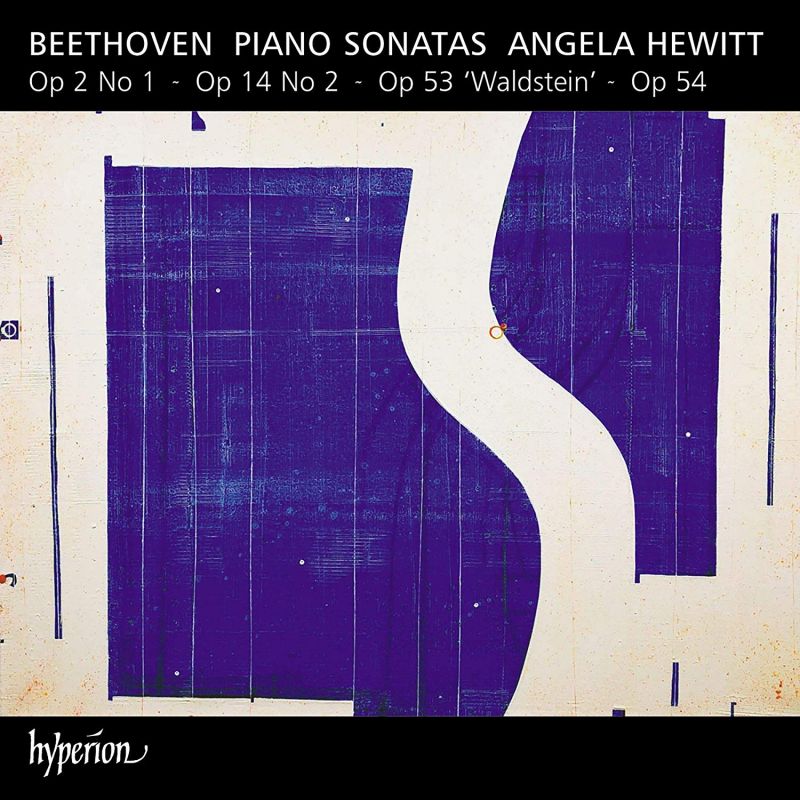BEETHOVEN Piano Sonatas (Biss. Hewitt)
View record and artist detailsRecord and Artist Details
Composer or Director: Ludwig van Beethoven
Genre:
Instrumental
Label: Hyperion
Magazine Review Date: 06/2019
Media Format: CD or Download
Media Runtime: 77
Mastering:
DDD
Catalogue Number: CDA68220

Tracks:
| Composition | Artist Credit |
|---|---|
| Sonata for Piano No. 1 |
Ludwig van Beethoven, Composer
Angela Hewitt, Piano Ludwig van Beethoven, Composer |
| Sonata for Piano No. 10 |
Ludwig van Beethoven, Composer
Angela Hewitt, Piano Ludwig van Beethoven, Composer |
| Sonata for Piano No. 21, 'Waldstein' |
Ludwig van Beethoven, Composer
Angela Hewitt, Piano Ludwig van Beethoven, Composer |
| Sonata for Piano No. 22 |
Ludwig van Beethoven, Composer
Angela Hewitt, Piano Ludwig van Beethoven, Composer |
Composer or Director: Ludwig van Beethoven
Genre:
Instrumental
Label: Meyer Media
Magazine Review Date: 06/2019
Media Format: CD or Download
Media Runtime: 64
Mastering:
DDD
Catalogue Number: MM19040

Tracks:
| Composition | Artist Credit |
|---|---|
| Sonata for Piano No. 8, 'Pathétique' |
Ludwig van Beethoven, Composer
Jonathan Biss, Piano Ludwig van Beethoven, Composer |
| Sonata for Piano No. 10 |
Ludwig van Beethoven, Composer
Jonathan Biss, Piano Ludwig van Beethoven, Composer |
| Sonata for Piano No. 22 |
Ludwig van Beethoven, Composer
Ludwig van Beethoven, Composer |
| Sonata for Piano No. 31 |
Ludwig van Beethoven, Composer
Jonathan Biss, Piano Ludwig van Beethoven, Composer |
Author: Harriet Smith
Hewitt begins with the very first sonata, the F minor, Op 2 No 1, and she emphasises the driving energy of the opening movement with a brisk accentuation that you will find exhilarating or brusque according to taste. The Adagio sounds somewhat forced, Goode more naturally poetic in his ornamentation, though the Menuetto comes off more convincingly. Hewitt is slower than some (Goode included) in the furiously energetic Prestissimo finale and I find her most convincing in the softer moments; in the louder ones her accentuation can grate.
Biss launches his disc with the Pathétique; the recording is close enough to catch occasional breathing, which initially distracted me, though the ear does adjust. I like the way he makes such a popular piece his own without resorting to exaggeration, with a very focused Allegro di molto and a simple songfulness to the Adagio theme, which is pedalled with subtlety, while that quality of haloed sound continues into the finale, which is combined with a tearing energy – faster than either Lewis or Goode but winningly so.
The different sound qualities that Biss and Hewitt bring is not just down to their different breeds of piano – a Steinway and a Fazioli: the opening movement of Op 14 No 2 is a far more cushioned affair in Biss’s hands, while he takes the main theme of the second, on which Beethoven builds his variations, at a slightly more lilting pace, one not dissimilar to Goode, though the latter finds even more ways to soften and vary the theme itself. I particularly like Biss’s first variation, a mix of charm and piquancy. Hewitt has a tendency to overplay the theme itself, so that the joke falls flat. She maintains a tight control over the finale, however, which comes across better.
Their readings of Op 54 again demonstrate their different approaches, Biss finding a nonchalance to the opening movement that makes the contrast with the octave outbreak potent indeed. Hewitt instead likes to guide her listener, demonstrating this point and that, which can distract. Her finale sounds too fragmented as a result, whereas Biss offers something more honed. I find Goode more effective than either, producing a wonderfully unruffled surface.
Hewitt precedes this with the Waldstein, emphasising the shocking juxtaposition of unlike with unlike in these two consecutive opus numbers. As you might expect, her way with the fingery textures of the first movement is dexterous and effortless, while the repeated left-hand chords have a crispness about them. But I find as a whole it lacks tension: the passage from 5'19", for instance, surely demands a degree of mystery as Beethoven takes us on a magical sequence; it is too clean-cut here. And the sense of intensity building through the movement is also in short supply compared to, say, Goode, who whips up a real storm, or Lewis, closer in tempo to Hewitt but with more sense of menace underlying the C majorishness. And in the Adagio molto, nicely paced, she doesn’t truly sustain the melody, making for a slightly chopped-up feel. Interestingly, Lewis is slower, but he manages to sustain Beethoven’s discourse very powerfully. Again, there’s a lack of tension at the start of Hewitt’s finale, and she makes rather too much of the triplet accompaniment from 1'18", lessening the sense of joyous release. To my ears, pianists such as Lewis and Goode are much more potent in this sonata as a whole.
Biss ends his disc with Op 110. His first movement speaks of long association with the music, with a nice sense of inevitability about it, and his Scherzo has none of the agogic distortion that coloured Sudbin’s recent account, though I do find Biss a little short on firepower – especially compared to Osborne, who conjures a sense of steel through this brief movement whether playing pp or ff. His Adagio ma non troppo opening to the finale is a less desolate affair than that of Osborne but the inevitability with which he builds the fugue is impressive indeed, his command of textures and line always compelling. If in the end it doesn’t have quite the emotional turmoil of Osborne, it’s a fine achievement nonetheless.
Discover the world's largest classical music catalogue with Presto Music.

Gramophone Digital Club
- Digital Edition
- Digital Archive
- Reviews Database
- Full website access
From £8.75 / month
Subscribe
Gramophone Full Club
- Print Edition
- Digital Edition
- Digital Archive
- Reviews Database
- Full website access
From £11.00 / month
Subscribe
If you are a library, university or other organisation that would be interested in an institutional subscription to Gramophone please click here for further information.




